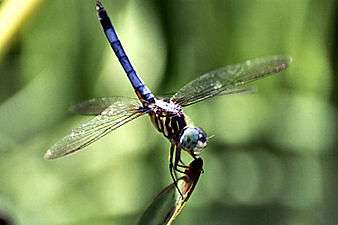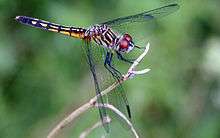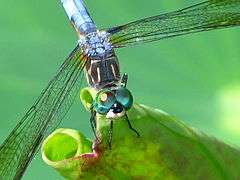Blue dasher
The blue dasher (Pachydiplax longipennis) is a dragonfly of the skimmer family. It is the only species in the genus Pachydiplax. It is very common and widely distributed through North America and into the Bahamas.[1]
| Blue dasher | |
|---|---|
 | |
| Male with raised abdomen that may be a threat display or a response to heat (the obelisk posture) | |
 | |
| Female | |
| Scientific classification | |
| Kingdom: | Animalia |
| Phylum: | Arthropoda |
| Class: | Insecta |
| Order: | Odonata |
| Infraorder: | Anisoptera |
| Family: | Libellulidae |
| Genus: | Pachydiplax Brauer, 1868 |
| Species: | P. longipennis |
| Binomial name | |
| Pachydiplax longipennis (Burmeister, 1839) | |
Although the species name longipennis means "long wings", their wings are not substantially longer than those of related species. Females do, however, have a short abdomen that makes the wings appear longer in comparison.[1] The blue dasher grows up to 25–43 mm long (1-1.5 in).
The males are easy to recognize with their vibrant blue color, yellow-striped thorax, and metallic green eyes. Females are somewhat less colorful than the male, an example of sexual dimorphism. While they have a matching yellow-striped thorax, their abdomen has a distinct brown and yellow striping that sets them apart from the male, along with contrasting red eyes. Both sexes develop a frosted color with age.[2]
 Male on a lotus leaf
Male on a lotus leaf
Habitat
Blue dashers live near still, calm bodies of water, such as ponds, marshes, slow-moving waterways, and ditches, in warm areas typically at low elevations. The adults roost in trees at night.[2]
Diet
These dragonflies, like others of their infraorder, are carnivorous, and are capable of eating hundreds of insects every day, including mosquito and mayfly larvae. The adult dragonfly will eat nearly any flying insect, such as a moth or fly. Nymphs have a diet that includes other aquatic larvae, small fish, and tadpoles.[3] These dragonflies are known to be voracious predators, consuming up to 10% of their body weight each day in food.[2]
The blue dasher hunts by keeping still and waiting for suitable prey to come within range. When it does, they dart from their position to catch it.[4]
References
| Wikimedia Commons has media related to Pachydiplax longipennis. |
- Needham, James G.; Minter J. Westfall, Jr.; Michael L. May (2000). Dragonflies of North America (rev. ed.). Gainesville, FL: Scientific Publishers. pp. 762–763. ISBN 0-945417-94-2.
- "OdonataCentral". www.odonatacentral.org. Retrieved 2017-01-31.
- "Blue Dasher". imnh.isu.edu. Retrieved 2017-01-31.
- http://ibis.geog.ubc.ca/biodiversity/factsheets/pdf/Pachydiplax_longipennis.pdf